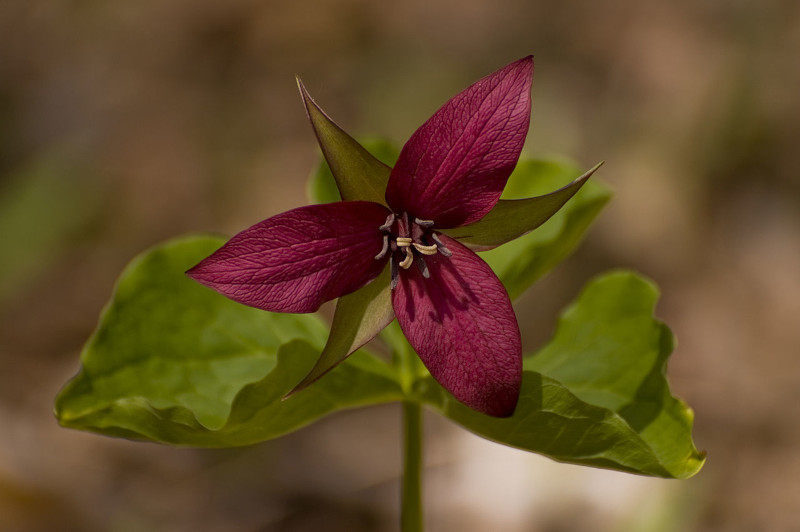
Red Trillium Facts
- The simple term Red Trillium serves as only one of multiple common names applied to this gorgeous product of Nature and evolution. These alternates vary quite widely, though. They include such diverse tags as wake robin, stinking benjamin, beth root, and birthroot.
- Inside of scientific circles, however, the wonder holds a much different title. Fortunately, at least as such things go, that’s a comparatively simple one for the layperson to pronounce. That’s because the stunning plant currently holds the technical designation Trillium erectum.
- This marvel of Nature received that particular epithet due to the efforts of Carl Linnaeus himself. The highly esteemed Swedish botanist recorded the first acknowledgement of it as a separate and fully distinct species. He managed that scientifically noteworthy feat in 1753.
- In widely scattered, individual portions of its greater overall native range, it now holds various levels of threatened status. This state occurs due to dangers posed purely to local populations of the beautiful Angiosperm. In each case, the precise reason for the status varies.
- Overall, though, the magnificent Red Trillium continues to maintain a population base that’s still stable and sufficient. That also holds true across the great majority of its range. The IUCN therefore currently lists it as Least Concern on its published Red List of Threatened Species.
- The species as a whole nevertheles still faces potential threats to its continued existence as a species. In this, however, it only mirrors the situation all life on the planet finds itself in now. We’re all dealing with the serious perils posed by habitat loss and ongoing climate change.
Related Articles
Red Trillium Physical Description
The highly distinctive beauty of the amazing Red Trillium rarely fails to captivate and enthrall those people fortunate enough to encounter it. This fabulous member of the lily Family clearly boasts some truly eye-catching characteristics. By its nature, it’s also a perennial herbaceous plant.
The plant evolved a rhizomatous root system, with comparatively thick, creeping rhizomes just below the soil surface. From this, however, the plant grows strongly vertically, thus the erectum base in the name. Ranging in height from 6 – 16 in (15 – 40 cm), it also typically remains unbranched.
Each separate stem generally produces three relatively large leaves. These structures display an ovoid shape, usually coming to a notably sharp point at the end. In color these present a moderate shade of green, and have a smooth texture. Each averages 6 in (15 cm) long and 2 in (5 cm) wide.
Intriguingly, the fruits of the remarkable plant technically qualify as berries, and remain small in size. This typically ranges from about 0.25 – 0.5 in (0.6 – 1.2 cm). Each begins as green in color, yet turns purplish as they ripen. The interior has a fleshy quality, and contains multiple small seeds.
Without doubt, though, the most distinctive and appealing feature of the Red Trillium for most who view the wonder is its flowers. This fact holds true despite their comparatively small dimensions. This just goes to further demonstrate that Nature does not ever equate size with impressiveness.
Each magnficent bloom averages measuring between 1 – 2 in (2.5 – 5 cm) in diameter. These consist of three elongated, oval-shaped petals. Each also usually shows a slight recurving, along with wavy edges. Perhaps most amazingly, though, in color, they present a deep red to maroon shade.
- Kingdom: Plantae
- Phylum: Tracheophyta
- Class: Liliopsida
- Order: Liliales
- Family: Melanthiaceae
- Genus: Trillium
- Species: T. erectum
Red Trillium Distribution, Habitat, and Ecology
Fortunately, the visually enthralling Red Trillium evolved as native to a reasonably moderate expanse of the suface of the earth. The exact location of that zone of habitation comes as no great surprise to those who know the region, though. It’s native to a certain portion of North America.
The breathtaking flora principally lives within the confines of the eastern portion of the United States and Canada. In the United States, the plant appears as far south as northern Georgia, and as far west as Minnesota. Meanwhile, in Canada, it lives as far north as Newfoundland and Labrador.
Much like many related species around the world, it displays decidedly clear preferences regarding its choice of habitat. Due to these, it most commonly appears in regions consisting of rich, moist, deciduous forests. Such locations provide it with the specific conditions which it needs to thrive.
One key component of this is very precise. This marvel of Nature needs soil that’s well-drained, but still maintains adequate moisture for its needs. It also requires high levels of nutrients in the soil, as well as shaded conditions. Given these, it most often lives as part of the forest understory.
The mesmerizing Red Trillium also serves a vital role in its local ecosystem. Its distinctive scent, often compared to a wet dog, attracts numerous insects, including beetles and carrion flies. While these pollinate the plant, ants subequently disperse the seeds, after taking them to their nest.
Its usefulness to the forest doesn’t simply end there, though. The many leaves and lovely flowers may be browsed by deer, while the seeds can be eaten by birds and small mammals. When its leaves and other organic matter decompose, they add organic material to the soil, enriching it.
Species Sharing Its Range
Brown Recluse Spider
Check out our other articles on 5 Captivating Caribbean Sea Species, Eastern Gray Squirrel, Table Mountain, Pom-pom crab, Eastern sweetshrub, Rose’s Ghost Frog, Green Iguana
